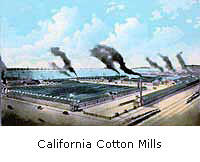The Land of Cotton

 In
1883, the south shore of Brooklyn Basin became the land of cotton. But
here the crop was not hand-picked by impoverished sharecroppers--it was
hauled in by rail to the California Cotton Mills. There, two Scottish
immigrants--John Yule Millar and William Rutherford--helped establish a
textile industry on the West Coast and a market for California-grown
cotton.
In
1883, the south shore of Brooklyn Basin became the land of cotton. But
here the crop was not hand-picked by impoverished sharecroppers--it was
hauled in by rail to the California Cotton Mills. There, two Scottish
immigrants--John Yule Millar and William Rutherford--helped establish a
textile industry on the West Coast and a market for California-grown
cotton.
The mill's largely Portuguese-American work force was paid its daily
wages in coin. The sound of the earnings tinkling in the pockets of
those workers--who settled in a company town beside the mill--gave the
neighborhood the nickname "Jingletown."
A new state-of-the-art facility replaced the original mill in 1917. Much
of the factory was demolished by the construction of the Nimitz Freeway
in 1954. Only a portion of the plant remains, a brick and glass relic of
Oakland's industrial heyday.
Steven Lavoie
Oakland Public Library, Oakland History Room
 "Walk Along the Water"
"Walk Along the Water"
© Oakland Museum of California, used with permission.

Update: The remaining mill structure has been awarded City of Oakland
Landmark status and converted to work/live lofts. A
brick wall
can be seen beside Freeway 880 where it cuts through the site of the original
mill. Bill Threlfall, Waterfront Action, 2009
 Explore this Topic:
Explore this Topic:
California Cotton
Mills Historical Video - Internet Archive
 Image
of twine works at California Cotton Mill, ca. 1890s - Oakland History Room, Oakland Public
Library
Image
of twine works at California Cotton Mill, ca. 1890s - Oakland History Room, Oakland Public
Library
 2009
photograph of remaining mill structure - Waterfront Action
2009
photograph of remaining mill structure - Waterfront Action
 2009
photograph of Freeway 880 where it cuts through the site of the original
mill - Waterfront Action
2009
photograph of Freeway 880 where it cuts through the site of the original
mill - Waterfront Action
 back to history map
back to history map